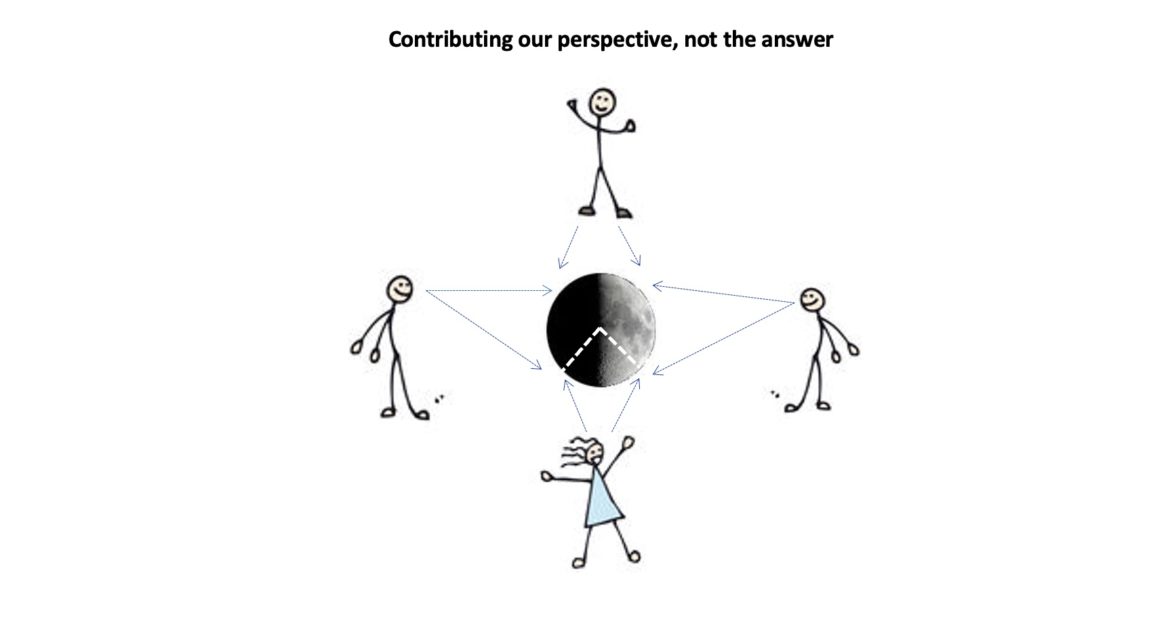The Value of Multiple Perspectives

As promised, I am sharing excerpts from The Shift from Me to Team, which will be published this year. The second part of the Introduction describes the limits of an individual’s perspective and the value of merging multiple perspectives to generate solutions.
MY REQUEST OF YOU: We are always open to learning and growing and would appreciate your feedback. Please share what you like and what could be improved. Your help is most appreciated. #leadership #foundationofgreatness #team #teamdevelopment
Our Perspective
Each of us is born into the world with a unique set of gifts and talents. As we blaze our trail through the jungle of life, we learn from our good and bad decisions. We begin to develop feelings for what is right and wrong. This is a big part of whom we become as we journey on our unique path. Our challenge is that the path we have been on is a mere sliver of life’s opportunities and experiences. Yet once we are far enough down the path, we feel we have answers; we have things figured out. The reality is that we do not have answers—we only have our perspective.
The best solution is found in valuing the meshing and merging of collective perspectives of team members. Each of us possesses our unique perspective, and together, with trust and respect, we can create the best answer possible. And we still can be wrong! However, we have achieved our responsibility to be the best we can be, and if wrong, we learn together for better decision-making in the future.
We like to use the imagery of the moon, which has a light side and a dark side. How many of us have gotten into an argument when the subject we are talking about seems very clear, yet we are only seeing one side?
Under Pressure
We may only see 180° or half of the problem on a good day, and that is just the reality. We have not had all the experiences needed to see the complete picture. Unfortunately, when we are under pressure, we see even less due to the stress on our physiology. We may see only one-quarter of an issue, but we dig in to protect our self-esteem because we feel threatened in this state. This often results in embarrassment and losing trust by not being open to others’ perspectives.
To be an effective leader, we need to understand that under pressure, we need to seek more diverse perspectives and not dig our heels in that we must be right. The shift is to think about what is best for the team and not me. The team will respect that they are valued and contributing to the benefit of the organization, and the leader will get the credit.
Here is an example of what we hear from our clients. This is the chair of an academic university medical department.
“We are surgeons, and we are used to making decisions by ourselves and getting the credit for our success. The FS/A culture process has taught us to think of others more and think in our team’s best interest for the benefit of our patients.
“I was surprised at the impact of giving power to the team. Instead of just saying, ‘Here’s the solution,’ we let the team develop a solution. It’s like a magical thing. It works much better than me telling them, even if it ends up being the same solution. Sometimes it’s a better solution than I’d come up with.
“Because we created our Guiding Principles together, we call each other on perceived boundary violations. These principles belong to our department, not any one of us. We try to have a non-hierarchical team as much as possible. We strive to create a team where all have the power to say something, to contribute.
“It’s hard. We try to create this feeling that everyone is equal in contributing to the team. Even though the contribution varies, everyone plays a role in our success. There’s still a hierarchy, but it works. People work well together for the good of everybody.”






